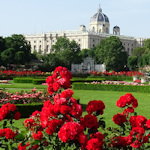
A beautiful landscaped park to one side of the Hofburg palace complex. Go when the roses are in bloom (you can thank me later).
- Central park famous for its lovely rose garden
- Go early for people-free photos of the flower beds
- Also home to the Theseus Temple, Sisi memorial, Grillparzer memorial, and a couple of cafés
- See also:
The “people’s garden”
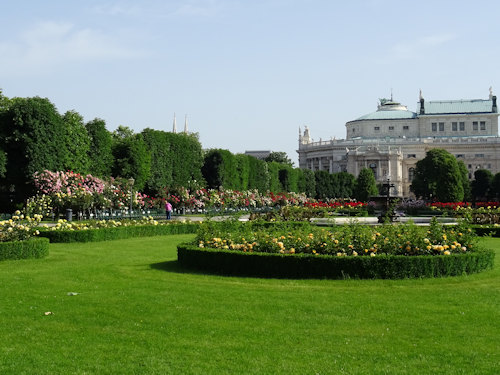
(View across the rose garden)
Opened in 1823, the Volksgarten owes its existence to the exuberance (and vindictiveness) of Napoleon’s army.
The French emperor entered Vienna in 1809 during the part of the Napoleonic conflicts known as the War of the Fifth Coalition. Holding all the negotiating cards, he forced the Austrian Empire to sign the Peace Treaty of Schönbrunn at great cost to the Habsburgs in terms of territories and prestige.
Then Napoleon’s troops left the city with their souvenir cakes and Mozart postcards, taking a few moments on the way out to blow up some of the fortifications.
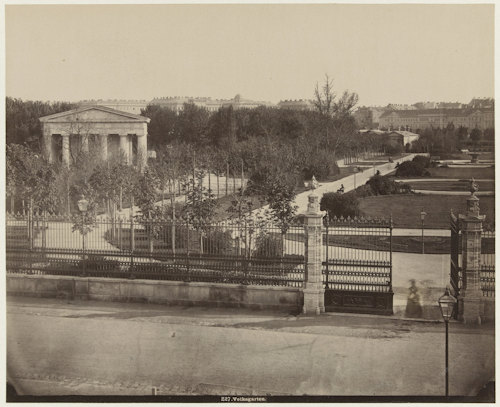
(The Volksgarten in the late 19th century. Image courtesy of the Rijksmuseum)
This kind farewell gift cleared quite a bit of space, which the authorities eventually turned into two parks and Heldenplatz square. Volksgarten was one of those parks. (So silver linings and all.)
The area found use as a place for a gentle stroll or a concert visit. Various members of the Strauss dynasty performed in the park, for example, and premiered new music there.
Johann Strauss I even named a piece after the location. The park’s music lovers greeted his Volksgarten Quadrille (Op. 157) at a soiree with what one newspaper of the time described as “tumultuous applause”.
Bits were added to the Volksgarten over the years as the Vienna city fortifications came down, and more land could be turned over to peaceful purposes.
So what’s inside the park?
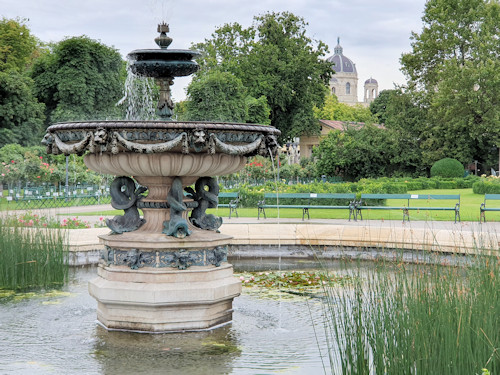
(One of the water features)
Think trees, shrubs, a few open spaces and water features.
But mostly think roses.
Are you thinking of roses?
Good.
Now think of even more roses.
Although the Volksgarten forms a triangle between one end of Heldenplatz, the Burgtheater and the Rathausplatz, many people think of it as the Rose Garden part that runs parallel to the Ring boulevard (see map below).
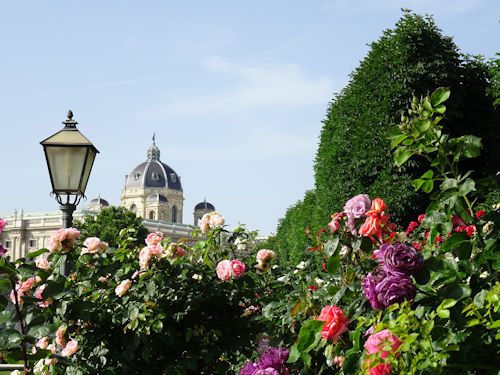
(A cornucopia of colour in historical surrounds)
Huge beds of tiered roses fill the sides of the Rose Garden: tall bushes at the back and smaller standards and bushes near the front. And each a different variety.
The flowers form a kaleidoscope of colour in the late spring and summer. And each rosebush carries a personal dedication to a lover, family member or similar.
If that’s not enough roses for you, there are more rose beds away from the edges, albeit mixed in with a few box hedges and similar.
The impression is magnificent, and I’d urge you to get there in the early morning in summer (June is a particularly good month) for glorious flower-filled photos undisturbed by visitors.
Other notable points of interest in the Volksgarten are…
The Grillparzer monument
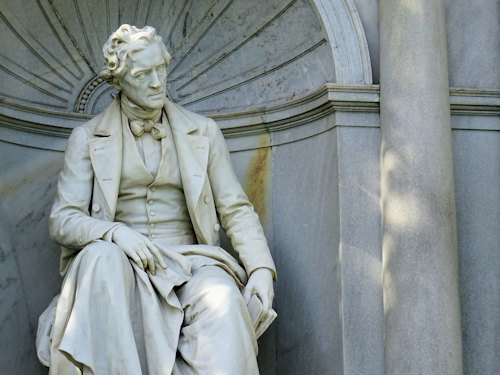
(One of the country’s great masters of the written word)
One end of the Rose Garden has a small monument to Franz Grillparzer (1791 – 1872), built in the late 19th century to honour the Austrian poet and writer.
Grillparzer once lived in the same house as Beethoven and even spoke at the composer’s funeral.
The Theseus temple
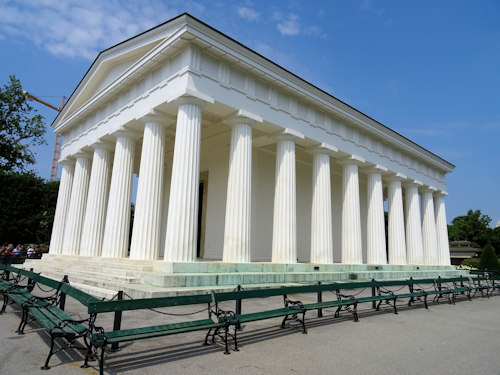
(A good spot for shade in summer. too)
In 1823, architect Peter Nobile constructed the neoclassical Theseus Temple, a smaller version of Athen’s Temple of Hephaestus.
The original function was to provide a home for Antonio Canova’s marble sculpture of Theseus battling a centaur following its purchase by the emperor of the time (the first Emperor of Austria, Franz I).
The temple has returned to its roots of late, hosting contemporary art installations under the aegis of the Kunsthistorisches Museum.
The Sisi memorial

(A small landscaped avenue leads down to a statue of the empress)
An extensive memorial site to Empress Elisabeth, completed in 1907, with a tree-lined avenue, fountains, water features and statue. It’s tucked away parallel to the Rose Garden and remarkably quiet in comparison.
For reasons I haven’t yet discovered, people tend to miss the memorial, despite its size. Even long-time residents sometimes express surprise at its existence. Strange when you consider that Elisabeth remains an icon of Austrian history.
How to get to the Volksgarten
The Volksgarten is about as central as it gets, across the road from the Rathaus and adjoining the giant square in front of the Neue Burg wing of the Hofburg Palace complex.
It has a tram stop (Ring/Volkstheater) and subway station (Volkstheater) outside, served by the U2 and U3 train lines and the 1, 2, D, 46, 49, and 71 trams.
Address: Volksgarten, 1010 Vienna